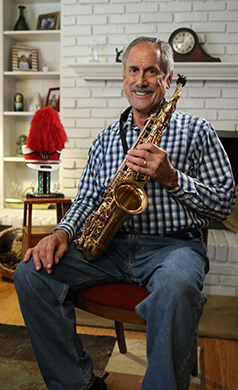When spinal stenosis left John Carmichael with a great deal of back, buttock, hip and leg pain, John felt he could either continue living with the pain or seek treatment options.
After all, John, a retired professor of conducting and director of bands at the University of South Florida, wasn’t one to rest on his laurels. Not long ago, he and his wife, Alisa, moved to be closer to family in Kansas City, where John soon started a nonprofit, 150-member professional concert band, Pinnacle Winds, serving as artistic director and conductor.
Seeking Relief
As a young man, John ran 5 miles every day. He took on racquetball as a change of pace, but the sport became too hard on his arthritic knees. He switched to bicycling about 7 miles a day in his 60s, but a bicycle wreck in 2016 left him with a concussion and broken vertebra.
“Although the accident may have exacerbated my situation, the arthritis in my spine was causing my pain and weakness,” said John, who is 70 years old.
Spinal stenosis occurs when spaces in the spine narrow, which creates pressure on the spinal cord and nerves. Osteoarthritis is often the culprit in this narrowing. “The pain restricted my activity so much that walking even 1 mile was difficult,” John said.
Pain medication and an epidural steroid injection gave John a temporary reprieve, but he sought greater relief. A friend’s recommendation brought him to David Ebelke, MD, an orthopedic spine surgeon with Spine Surgery Ltd. and North Kansas City Hospital’s spine medical director.
“Eventually, most people with bad spinal stenosis like John’s get to the point when they feel they have to do something,” Dr. Ebelke said. “John was substantially limited and wanted to consider something definitive. I recommended addressing his hip, buttock and leg symptoms through decompressive surgery, but I explained it would not alleviate the disc disease causing his back pain. We discussed doing a possible spinal fusion down the road for his back pain.”
John appreciated Dr. Ebelke’s candor. “I met with a few spine surgeons, and Dr. Ebelke gave me the most complete picture of my situation and my possible outcomes,” John said.
Relieving the Pressure
 During John’s March 9 surgery, called a laminectomy, Dr. Ebelke sought to take the pressure off John’s spinal nerves and give them more space. This meant remodeling the spinal canal by cutting away small portions of bone and ligament from John’s spine, which were compressing the nerves. The lumbar spine in the lower back has five bones, known as L1-L5. John had stenosis from L2-L5, which meant he needed a three-hour, multilevel decompression surgery.
During John’s March 9 surgery, called a laminectomy, Dr. Ebelke sought to take the pressure off John’s spinal nerves and give them more space. This meant remodeling the spinal canal by cutting away small portions of bone and ligament from John’s spine, which were compressing the nerves. The lumbar spine in the lower back has five bones, known as L1-L5. John had stenosis from L2-L5, which meant he needed a three-hour, multilevel decompression surgery.
“In the remodeling, it’s important to not take too much, only opening the spinal canal enough to create more space for the nerves to move freely,” Dr. Ebelke added.
Stepping Ahead
Relief came quickly after John’s surgery.
“I had greatly reduced pain and numbness. I stayed one night at North Kansas City Hospital, and the staff impressed me. It’s one of the better hospitals I’ve been in. Shortly after getting home, I was even hitting golf balls,” said John, adding the surgery allowed him to be back playing his banjo, clarinet, classical guitar, flute, saxophone, steel-string guitar and 12-string guitar.
Eight months after his surgery, John’s level of pain in his hips, legs and thigh remains greatly improved. He attributes a bout of recent back and buttock pain in part to overdoing it in a recent move, but an epidural steroid injection relieved him from the pain.
“I am doing physical therapy and started using a recumbent bike. Over the summer, I kept up with mowing my lawn and other yardwork,” John said. “I will sing Dr. Ebelke’s praises for his honesty and candor. His explanations and work were first-rate.”